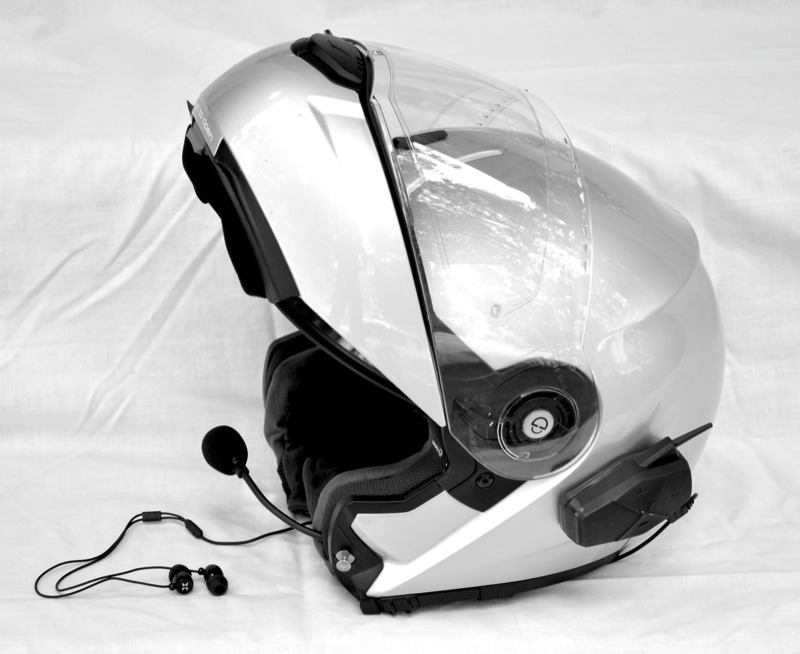The Raptor-i from Vertix does all that we expect of a Bluetooth helmet communication system, and a bit more. For tour guides, couples that like to chat during long rides, those who suffer anxiety when separated from their cell phones for more than a few minutes, riders who want robotic voices to give directions and individuals who desire tunes for road trips, the Raptor-i may be the ultimate solution to preventing loneliness in a helmet.
The lightweight control unit fits onto the side of a helmet using a very secure type of hook-and-loop closure. The EZ-Mount is claimed to be secure up to 130 mph, but my tests were limited to highway speeds. The in-helmet audio system simply plugs into the control unit.

The surface of the control unit is divided into four large buttons—on/off and intercom selection, volume up, volume down and phone/FM/Music switch—with an L.E.D. indicator in the center. Audio signals in high and low pitch indicate whether Bluetooth connections and mode switching has been successful. The Raptor-i can be “paired” with up to three units, but only two can be in open communication at a time. The initiate button is used to switch between unit 1 and either 2 or 3.
I tested both the boom mic version with helmet speakers (included in price) and the boom mic version with ear buds (additional $23). The latter includes three different sizes of silicon plugs to ensure a comfortable fit.
The boom mic works fine with both modular and open-face helmets and the speakers simplify the process of putting on/taking off the helmet. The ear buds insulate wind noise and thereby clarify reception, which becomes especially important for music and/or phone calls. If you wear different helmets when on different bikes, I recommend the ear buds with a boom mic.
This is not a VOX system: Riders are in constant communication, which means that wind noise and other ambient sounds are transmitted even when you’re not talking. The computer chip, featuring “adaptive noise-cancellation performance” DSP technology, does an excellent job of muting wind noise, but it can still be heard. However, the automatic gain control does help to counter variations in ambient noise. Of course, factors like wind noise are highly dependent upon whether a wired-in microphone is used in a full-face helmet or a boom mic in an open-face one. The quietness of the helmet, the degree of wind protection from fairings/windshields and the speed the motorcycle is traveling are other mitigating factors. (I used a Nolan N-90 modular helmet and three different bikes for this test.)

Like its major competitors, this is a line-of-sight communication system: Go around a building or over the crest of a rise and you will lose the signal. Vertix claims a range of 500 meters (1,640 feet) but in the real world, no Bluetooth helmet communication system reliably works beyond a quarter-mile of separation regardless of the manufacturer’s claim.
Linked to a Bluetooth-compatible cell phone the Raptor-i allows voice dialing, automatic call answering after three rings, call reject, call redial, last number redial, call transfer and an independent phone-volume control. It also will receive audio directions from a Bluetooth GPS navigation unit, and automatically switches off to accept an incoming phone call and then automatically resumes when the call is ended.
For those who prefer listening to tunes while riding, the Raptor-i has a built-in FM radio with memory for eight stations and volume control that’s independent of other functions. With compatible Bluetooth A2DP music players, the A2DP protocol allows for music functions like switching tracks and adjusting volume to be verbally controlled. As with the FM radio and GPS function, the music switches off when a phone is being used and resumes when the call has ended.
Personally, I’m concerned about the safety issues of fiddling with a complex switching device on the side of my helmet while going down the highway. Nor for that matter do I advocate using a cell phone while riding. Regardless, Vertix offers another sweet option: the RTR-RC-01 Remote Control Unit ($77). This attaches to a hand grip and, using infrared transmission, duplicates the switches built into the control unit. It’s far less distracting to use the remote and your hand stays on the bars. (The remote control unit is powered by a CR2032 watch battery.)
The Raptor-i does everything its higher-priced competitors do, and it suffers the same limitations. Rider-to-passenger communications are flawless, but rider-to-rider linkage breaks down with distance and interference from certain radio and electromagnetic sources operating in the vicinity. Like similar systems, it does require a steep learning curve and practice to operate all the control options with confidence and precision. VOX versus DSP technology may be a hot topic for audio geeks, but in practice it comes down to personal preference. Other personal preferences are wired-in microphone versus boom, and helmet speakers versus ear buds. At least Vertix offers the buyer the choice of which mic/audio combination is preferred. The Remote Control Unit is a major innovation that sets the Raptor-i beyond its competition. The charged battery is sufficient for 10 hours of continuous usage and will hold a charge for a month. An optional “continuous charge system” was not tested.
Vertix Raptor-i Helmet Communications System
Control unit with FM radio, wall charger, helmet speakers and microphone (wired or boom): $187
www.vertix.com.sg


















